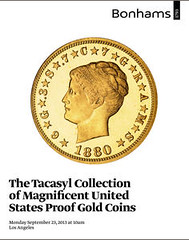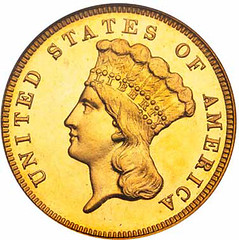
PREV ARTICLE
NEXT ARTICLE
FULL ISSUE
PREV FULL ISSUE
BONHAMS TO SELL TACASYL U.S. PROOF GOLD COINS The September 23 Bonhams Coins and Medals auction
includes the "Tacasyl Collection of Magnificent United States Proof Gold Coins" , a "27-strong selection assembled by a private collector of nearly every major American gold coin design in proof between 1836 and 1915." The catalog is available online and the descriptions contain some interesting bits of information about these coins.
-Editor
The September 23 Bonhams Coins and Medals auction
includes the "Tacasyl Collection of Magnificent United States Proof Gold Coins" , a "27-strong selection assembled by a private collector of nearly every major American gold coin design in proof between 1836 and 1915." The catalog is available online and the descriptions contain some interesting bits of information about these coins.
-Editor
Lot 1007, 1885 $3


The reasons for creating such an odd denomination remain somewhat hazy, but the first suggestion for the denomination dates back to June, 1832. Whether historically founded or not, numismatists have suggested with some common-sense that the denomination was created to pay for large purchases of 3-cent postage stamps (100 to a sheet). Regardless of the reasoning, the denomination was never popular. (Professor John Alexander, one of the first proponents of an international coinage in the mid-1850s, called the denomination “an excrescence”). During its entire thirty-five year production from 1854 until 1889 only about 16,300 three dollar gold pieces were produced in total (compared, for example, with the nearly 600,000 Quarter Eagles struck in Philadelphia in 1854 alone). Of that total a meager 2,000 pieces were struck as proofs, and a fraction of those have survived. Lot 1008 1879 $4 Stella

Although the Stella is undoubtedly America’s best known physical manifestation of an international currency, the idea of coinages which were of equivalent value and convertible in other countries was not new. According to a recent article, in 1855 Professor John H. Alexander published a pamphlet on an international coinage for the United States and Great Britain. The concept was to have the sovereign and half eagle of equal gold content and value. The idea reached the halls of Congress, which subsidized an exploratory trip to Great Britain for the professor, but following Alexander’s report the program failed to win support. In Europe, the Latin Union was formed in 1865 and seven countries agreed to adopt the French currency system. The members of the Union would produce coins of a national character, but their value and underlying gold content would be based on the French franc. In Paris, two years later at an International Monetary Conference it was agreed (in principal) that all conferees would adopt a similar system, but in subsequent debates the system, largely on nationalistic grounds, was defeated. France’s defeat in the Franco-Prussian War ended enthusiasm for the idea until 1878, when a second conference was held, again in Paris, at the urging of the United States. This time it was an international bimetallic standard that was proposed and it was as a result of this second conference that the Stellas were developed, largely at the urging of John Kasson, the United States Minister to Austria. With Congressional approval and the support of the Secretary of State, the Mint was ordered to develop a coin which could not only circulate around the world, be recognized as an international coin, but also indicate its value in a similarly multi-national way. The Mint’s solution to all of its charges was common sense: the value of the coin was expressed not only in dollars (Four), but in the metallic composition of the coin itself; 6 grams gold; .3 grams silver; .7 grams copper. To achieve this alloy, the Philadelphia Mint’s assay shop simply mixed the correct proportions. Finally, to create an odd sized planchet, half eagle blanks were adjusted (probably by hand, as the striations vary from one example to another) to the correct weight. When completed, the newly struck patterns were forwarded on to the Coinage Committee in Congress for approval. Word of their unusual design and beauty quickly made the Washington, D.C. rounds and additional examples of the 1879 Flowing Hair variety were struck to satisfy Congressional demand. Ultimately though, like earlier efforts to create international coinage, legislators scuttled the plan, but not before creating one of the United States’ most sought-after collector coins.
To view the complete catalog, see:
www.bonhams.com/auctions/20992/
The Numismatic Bibliomania Society is a non-profit organization promoting numismatic literature. See our web site at coinbooks.org. To submit items for publication in The E-Sylum, write to the Editor at this address: whomren@gmail.com To subscribe go to: https://my.binhost.com/lists/listinfo/esylum All Rights Reserved. NBS Home Page Contact the NBS webmaster 
|